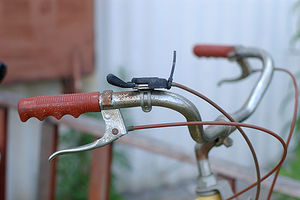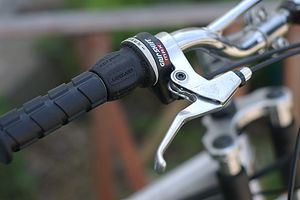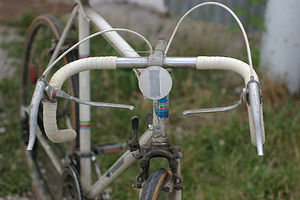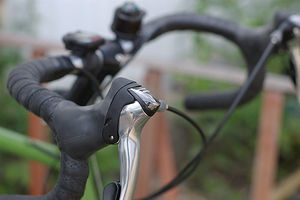Es posible que algunxs usuarixs de Firefox tengan que conectarse más de una vez para iniciar sesión. Es un error conocido de Firefox. Marca "keep me logged in" (mantenerme conectado), puede ayudar.
Handlebars: Difference between revisions
({{Parts}}) |
(Rewrite on parts page to include bar variants and more integration to shifter and brake lever pages) |
||
| Line 1: | Line 1: | ||
Handlebars are the mechanism for controlling steering on a bicycle. They also support part of a rider’s weight, depending on position, and provide a location for mounting other controls, such as [[shifters]] and [[brake levers]], and accessories, such as a reflector, light, bell, or side mirror. Handlebars attach to the [[stem] via a clamp. | |||
==Types== | |||
There are two broad categories of handlebars. These are flat and drop handlebars. While each is named for the most common variant within them, they are categorized according to the diameter of the tubing, particularly that in the grip area. Both due to design and tubing diameter differences, each style has associated controls and accessories. These differences and some variants of each style are discussed below. | |||
== | ===Flat === | ||
[[Image:oldflat.jpg|thumb| | [[Image:oldflat.jpg|thumb|Upright bar]] | ||
[[Image:newflat.jpg|thumb| | [[Image:newflat.jpg|thumb|Riser bar]] | ||
One type is | One style of handlebar is the flat handlebar. The conventional form of this type consists of a straight tube, hence the name. The grip area diameter of this tube is 22.2 millimeters while the clamp size may be either 25.4 millimeters, as on older bikes, or 31.8 millimeters, for some more modern bikes. | ||
Flat handlebars are held by rubber grips at the bar end and the bar is either covered by the grip or by a plug. They all share a [http://www.bikecollectives.org/wiki/index.php?title=Brake_Levers#Flat_Style similar style of brake lever] and may use thumb, grip, or trigger [[shifters]] | |||
Flat bars come in a number of variants. The following is a list of some such variants. | |||
* Riser | |||
* Upright or North Road | |||
* BMX | |||
* Cruiser | |||
===Drop === | |||
[[Image:oldroad.jpg|thumb|Old drop bar with extension brake levers]] | |||
[[Image:newroad.jpg|thumb|New drop bar with integrated shifting]] | |||
The other style of handlebar is the drop handlebar. These handlebars are bent in such a way to provide multiple hand positions, including a low, aerodynamic position from which they derive their name. The grip area diameter of this tube is 23.8 millimeters while the clamp size may be either 26.0 millimeters, as on older bikes, or 31.8 millimeters, for some more modern bikes. | |||
Drop handlebars may be gripped anywhere along the bar, which is typically covered by some sort of [[bar tape]] for comfort. Bar ends are covered by a plug that also often doubles to secure the bar tape. | |||
They all share a [http://www.bikecollectives.org/wiki/index.php?title=Brake_Levers#Drop_Style similar style of brake lever], which can be activated while on the hood or in the drops. Old examples of such brakes incorporated [http://www.bikecollectives.org/wiki/index.php?title=Brake_Levers#Extension_Levers extension brake levers] for use while on the flat portion of the bar. More modern examples have done away with this, but may be paired with [http://www.bikecollectives.org/wiki/index.php?title=Brake_Levers#Interrupt_Levers interrupt brake levers] for this purpose. | |||
On old bikes with drop bars, the shifters were commonly on the downtube or stem. Some have what are called bar end shifters, which take the place of plugs. Modern bikes with drop bars often use shifters that is integrated into the brake level, often called [[brifters]]. | |||
Drop bars come in a number of variants. The following is a list of some such variants. | |||
* | * Traditional | ||
* Randonneur | |||
* Track | |||
<!-- Bullhorn or Pursuit --> | |||
<!-- By design ; Tubing of flat bars --> | |||
<!-- “Flop and chop” drops; Drop bar flipped over, [[Making “flop and chop” bullhorn bars]] --> | |||
<!-- Variation; Anything goes, bar end (tri) brake levers, road style brake levers --> | |||
<!-- Aero or Triathlon --> | |||
== | ==Summary of [[Important Points on Handlebars]]== | ||
== See Also == | == See Also == | ||
* [[Wrapping Handlebars]] | * [[Wrapping Handlebars]] | ||
== Spanish == | == Spanish == | ||
Revision as of 13:07, 22 December 2014
Handlebars are the mechanism for controlling steering on a bicycle. They also support part of a rider’s weight, depending on position, and provide a location for mounting other controls, such as shifters and brake levers, and accessories, such as a reflector, light, bell, or side mirror. Handlebars attach to the [[stem] via a clamp.
Types
There are two broad categories of handlebars. These are flat and drop handlebars. While each is named for the most common variant within them, they are categorized according to the diameter of the tubing, particularly that in the grip area. Both due to design and tubing diameter differences, each style has associated controls and accessories. These differences and some variants of each style are discussed below.
Flat
One style of handlebar is the flat handlebar. The conventional form of this type consists of a straight tube, hence the name. The grip area diameter of this tube is 22.2 millimeters while the clamp size may be either 25.4 millimeters, as on older bikes, or 31.8 millimeters, for some more modern bikes.
Flat handlebars are held by rubber grips at the bar end and the bar is either covered by the grip or by a plug. They all share a similar style of brake lever and may use thumb, grip, or trigger shifters
Flat bars come in a number of variants. The following is a list of some such variants.
- Riser
- Upright or North Road
- BMX
- Cruiser
Drop
The other style of handlebar is the drop handlebar. These handlebars are bent in such a way to provide multiple hand positions, including a low, aerodynamic position from which they derive their name. The grip area diameter of this tube is 23.8 millimeters while the clamp size may be either 26.0 millimeters, as on older bikes, or 31.8 millimeters, for some more modern bikes.
Drop handlebars may be gripped anywhere along the bar, which is typically covered by some sort of bar tape for comfort. Bar ends are covered by a plug that also often doubles to secure the bar tape.
They all share a similar style of brake lever, which can be activated while on the hood or in the drops. Old examples of such brakes incorporated extension brake levers for use while on the flat portion of the bar. More modern examples have done away with this, but may be paired with interrupt brake levers for this purpose.
On old bikes with drop bars, the shifters were commonly on the downtube or stem. Some have what are called bar end shifters, which take the place of plugs. Modern bikes with drop bars often use shifters that is integrated into the brake level, often called brifters.
Drop bars come in a number of variants. The following is a list of some such variants.
- Traditional
- Randonneur
- Track
Summary of Important Points on Handlebars
See Also
Spanish
Manillar (f)
|
Bicycle Parts |
|||||
| Ball Bearings • Brakes (Caliper Brakes, Cantilever Brakes & Disc Brakes) • Brake Levers • Chainrings • Chains • Cranks | |||||
| Derailers (Front & Rear) • Forks • Frame • Front Derailers • Handlebars • Hubs • Pedals • Quick Release | |||||
| Rim • Seatposts • Seats • Shifters • Skewer • Spokes • Stems • Tires • Tubes • Wheels |



